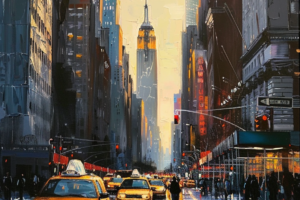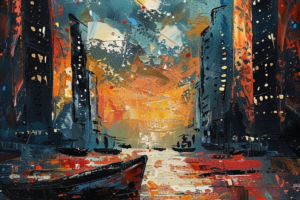An art projector could be the tool you never knew you needed. As an artist, using a projector can improve your artwork and simplify your processes.
Photorealist artists have been using these useful gadgets for decades. But any artist can benefit from adding a projector to their studio.
It makes it so much easier to enlarge your designs, trace on canvas, or even outline a mural.
- 【Official Netflix License, Watch Shows Online】VOPLLS Smart Projector with built-in smart operating system that supports over 1,000,000+ videos, including certified Netflix, Prime Video, and YouTube. With just one click, you can quickly enjoy your favorite movies and TV shows without purchasing an additional TV stick. Besides, you can access the "Open Browser", "My App", and "APP STORE" for unlimited entertainment options at any time!
- 【Auto Focus & Keystone Correction and 180° Integrated Stand】VOPLLS projector utilizes state-of-the-art AI focusing and displacement gyroscope technology that detects in real-time and automatically corrects within 3 seconds to ensure a clear projection. Equipped with a 6D keystone correction function, it can automatically adapt to any wall and remove the restriction of placement. 180° rotatable Stand simplifies the installation and realizes the best projection effect in any scene.
- 【True Audio-Visual Feast, 3D Stereo Sound】 VOPLLS video projector with built-in hi-fi stereo speakers, and unique sealed core technology that effectively reduces noise by up to 80%, allow you to fully immerse yourself in the 3D stereo sound environment. The icing on the cake is that VOPLLS bluetooth projector can also connect to external speakers or use it as a standalone speaker via Bluetooth 5.2.
- 【Achieve Zero-Latency 2.4G/5G Dual-Band WiFi Connection】VOPLLS wifi projector boasts a robust 2.4G/5G dual-band WiFi connection, facilitating seamless linking to your cell phone or computer, ensuring immediate and steady transmission. Bid farewell to delays or lags in projection, significantly enhancing gaming and wireless projection encounters, notably during Switch/PS4/5/X-box sessions. VOPLLS outdoor projector is perfect for those who favor the big screen movie/gaming experience.
- 【4K Supported, 600 ANSI Brightness, Worry-free Shopping】 With native 1080P resolution, 600 ANSI brightness, 15000:1 high dynamic contrast ratio, VOPLLS 4k projector is at least 95% brighter and clearer than other 1080P projectors. Whether day or night, at home, outdoors, or in business meetings, indulge in the ultimate joy of projection anytime, anywhere.In addition, the quick response within 12 hours, 2-year product replacement warranty and lifetime after-sales service make you worry-free.
- 💯【2.4+5G Wifi and Bluetooth 5.1 Projector】Projector with wifi and bluetooth, with built-in upgraded speaker, you can enjoy a cinematic audio-visual experience without connecting external speakers. Also, this portable projector built-in Bluetooth 5.1 technology to make the audio synchronization faster and more stable. With this Bluetooth projector, you can connect your ideal Bluetooth speakers or headphones wirelessly at any time to get more wonderful sound
- 💯【Native 1080P Full HD Resolution iPhone Projector】: The projector is an excellent device that allows you to watch HD movies, with 1920*1080 native resolution, excellent 14000L brightness, and 10000:1 high dynamic contrast ratio, providing Sharper, brighter, and richer images! Let's enjoy the movie time
- 💯【Wifi Mirroring Wireless Screen Casting】 Supports cell phone mirror wireless screen casting, which brings you a more convenient screen casting experience. Projector support multi lay way to convenient for you to watch, front, rear, and ceiling cast. Just enjoy your fun home theater
- 💯【Portable Mobile Home Cinema】ZDK projector provides a minimal display area of 35” to a maximum 300” image. It enables excellent playback of movies, TV shows, video games and can be set up conveniently. Our newly improved 2024 uniform illumination method provides the optimal visual experience, ensuring no dark areas are present along the edges of the displayed image
- 💯【Extensive Connection Compatibility】With the built-in HDMI, VGA, AV, USB, AUX, MicroSD, plus included AV & HDMI cables, this portable projector is the perfect solution for a wide variety of input sources including but not limited to TV Stick/Box, Game Consoles, PCs, Smartphones, Tablets, Laptops, DVD players, TF cards and USB flash drives. We provide multimedia compatibility
- 💖【Native 1080P Full HD Resolution] The projector can deliver you HD movies with 1920*1080 native resolution, which is 4k supported. Equipped with excellent brightness and 10000:1 high dynamic contrast ratio, the hd projector provides sharper, brighter, and richer images! (Portable Projector 100'' Screen Included).
- 💖【200” Giant Screen &±15°Keystone Correction] Mini Portable projector provides 40-200 inches projection display, at 6.8-16.4 feet projection distance. Keystone correction make setting up and getting the perfect screen position a breeze. It is a good choice as a indoor bedroom home theater, and also good for outdoor movie night for families.
- 💖【Bluetooth 5.1 Function & HiFi Stereo Speaker] The movie projector has built-in powerful dual speakers, that offers you crisp clear sound and excellent auditory sense experience. The bluetooth projector support wireless connecting bluetooth speakers, soundbar, headphones and other audio equipment through bluetooth 5.1 chip. So you can experience the cinema-level surround effect at home.(Bluetooth does not support connecting smartphones and Alexa, only audio devices).
- 💖【Multimedia Compatibility] The TV theater projector equip with HDMI / USBx2 / AV / 3.5mm headphone jack, compatible with Fire TV Stick, Roku, DVD, Laptop, USB, Computer, Headphone, External Speaker, iPhone, Android, iPad, PS5, PS4, etc. The Projector supports desktop/ceiling/tripod placement. You could use it for garden parties, backyard movie night, outdoor camping, and more.
- 💖【What You Get] You can get a package including Native 1080P projector *1, 100” projector screen *1, AV Cable *1, HDMI Cable *1, Remote *1,User Manual *1. The video projector is perfect for home entertainment, backyard, gaming, yoga, music and parties. HAPPRUN ensures you with an 24-month pleasant experience and top customer service. Please feel free to let us know if have any questions about this HAPPRUN projector.
- 🔥【180°Rotatable Phone Projector & 200'' Giant Screen】This smart projector features a 180 ° rotatable design, allowing you to point the 180 ° tilted projector in various directions, including the ceiling. You can point the projector at your bedroom ceiling and lie in bed watching the movie. And it can deliver a clear picture on screens from 40 to 200''. It can produce a really big image in your living room, family room, and other areas of your house.
- 🔥【Android 11 & Built-in dual band WiFi 6】This mini portable projector built-in dual 5G+2.4G latest wifi 6 connection. Ultra-fast 5G WiFi 6 offers you much smoother and lag free online video experience. This means that projection will be quicker and more reliable. Just one-time wifi connection. With Android 11, no matter where you go, indoor or outdoor, you can watching movies or presentations on your favourite platform. No need to purchase additional TV box. Very suitable for outdoor events.
- 🔥【BT 5.0 & Speaker】This mini wifi projector built-in 5W stereo speakers with a HiFi system which can give a great auditory sense experience: a ultra clear and powerful sound. So you don't need to buy additional speaker. You can enjoy home theatre with your family. This projector also with BT 5.0, which allows you to connect ideal headphones, speakers, or other audio equipment, it can support stable connection to various BT speakers. Perfect for outdoor movie
- 🔥【8000 Lumens & 4K Support & Auto Horizontal Trapezoid Correction】This mini projector with high resolution 720P Full HD Native and 1080P 4K support, and has impressive picture quality, good brightness 200 ANSI 8000Lumens, vivid colors and contrast ratio 10000:1. Which can deliver good picture for you. And this projector offers auto horizontal keystone correction and manual trapezoidal correction, which can help you easy to set up trapezoidal image with correct proportions and angles.
- 🔥【Portable Size & Long Time Life & Satisfied Warranty】This smart projector adopts imported concentrating technology 3 pieces glass lens. It's compact enough to be packed in a bag for travel or bringing on camping trips. And with a light source life of up to 50,000 hours. Easily meet your movie, match, and game needs. If you have any problems while using, please feel free to contact us. We offers 2-year product replacement warranty and 100% satisfaction guarantee.
- 💝 4K Projector & 600 ANSI Lumen: GooDee all new upgraded mini wifi projector adopts 6 layers high Refractive glass lens which means this portable projector will deliver a evenly distributed, no-blurry-edges image; Using Germany imported chips and Japanese native light bulbs which bouble level up the image brightness, clarity, color richness, restore the authenticity of color to the maximum extent. Best suits for indoor outdoor use.
- 👫 Faster & Stable 2.4G/5G WiFi & Bluetooth Connection: Owning GooDee projector with wifi and bluetooth, which allows you to synchronize smartphone screen by both 2.4G and 5G WiFi, Ultra-fast 5G WiFi offers you much smoother and lag free online video streaming experience. Just one -time wifi connection. By connecting newest built-in 5.2 Bluetooth, you can enjoy the various bluetooth speaker sound.
- 💝 300 “Max Screen with Zoom Function: GooDee outdoor movie projector provides zoom 50% to 100% which means you can adjust the screen size at a fixed place, you don’t need to move the video projector any more. Just bring the home movie theater back to your home, enjoy ultra-clear large-screen movies as if you were in a movie theater.
- 👫 Dolby Audio & Built-in Hi-Fi Stereo Speaker: As a multi-function home cinema projector, YG600 Plus has built-in 2* 5W speaker giving a ultra clear and powerful sound. Just one click to start your night life. Genuine Dolby authorization, so that you will no longer have only the picture but no sound, and enjoy the ultimate 3D surround sound.
- 💝 No More Black dot & Lifetime Warranty: Adopting imported High-tech materials, it can block dust and prolong the life of the projector. GooDee provides a lifetime warranty, if there have any questions, please feel free to contact us. 7x24 online.
- ➤【Innovative Auto Focus and Auto Keystone Correction】WiMiUS's first auto focus projector is here! P62 video projector adopts auto-focus and 6D auto-keystone technology, Say goodbye to troublesome manual adjustment, and you can get a clear rectangular picture within 5 seconds after starting up! The built-in displacement sensor can detect the movement of the projector at all times. Even if the projector is moved, the P62 can automatically adjust the focus and correct the image.
- ➤【Native 1080P & 600 ANSI & 20000:1 Contrast Ratio】P62 WiFi and Bluetooth projector adopts imported concentrating technology glass lens, with high-definition native 1080P and 20000:1 high dynamic contrast ratio, and supports 4K video. With 99% NTSC technology, it highly restores the original image without compressing the picture quality, giving you the best game and movie look and feel.
- ➤【The First Wi-Fi 6 Projector】Wi-Fi 6 is not only compatible with 2.4GHz and 5GHz networks, the maximum rate can reach 9.6G bps. As the first projector equipped with WiFi 6, the P62 can achieve smoother and more stable content transmission when used with a WiFi 6 router, and the projection will no longer be delayed and stuck, which greatly improves the gaming experience and wireless projection experience. Ideal for patrons who prefer a big screen movie/game experience.
- ➤【Upgrade Bluetooth 5.2 and Hi-Fi Built-in Speaker】The Bluetooth projector P62 is equipped with the latest Bluetooth 5.2 chip, which supports stable connection to various Bluetooth speakers, bringing you more shocking and immersive sound. With built-in 12W stereo speakers, P62 is both a smart projector and a standalone Bluetooth speaker, providing great loud sound for your home theater without connecting external speakers.
- ➤【Fully Sealed Engine and Multi-device Connection】P62 is based on a fully sealed optical core, which is not easy to enter dust, effectively reducing screen black spots and image quality loss, so that P62 can accompany you for a longer time. Equipped with AV/USB*2/HDMI*2/audio ports, it can easily connect Phone/PC/TV Stick/Switch. ➤For any questions, our 24/7 after-sales email support, 2-year Money Back guarantee, 3-year Repair warranty, and Lifetime Technical Support are at your service.
- NEW 2023 MODEL: Upgraded 3800 ANSI Lumens paired with an improved 15,000:1 contrast ratio (FOFO) when compared to its predecessor, TH585P.
- 1080P RESOLUTION: 1080p Full HD image quality with 3800 ANSI lumen for ultimate gaming experiences in well-lit environment
- LOW LATENCY: 16ms (1080p@60Hz) low input lag and microsecond DMD fast response ensure ultra-smooth gaming experiences
- HIGH CONTRAST RATIO: Produces deeper black fine details in dark scenes without washout.
- TAKING VIDEO GAMES TO THE BIG SCREEN: The short throw projection produces big 100" images from just 10.8ft for total gaming immersion
- 【1080P Full HD High Performance Projector】Mini projector with native resolution of 1920*1080 and contrast ratio of 10000:1, support 4K. HOMPOW Portable projector brings you a 35% brighter images than similar projectors in market, which presents our customers a dynamic and color vibrant 1080P HD projected image quality
- 【Bluetooth Connection & HiFi Stereo Speaker】Bluetooth projector support achieves you various Bluetooth speakers and headphones immersive sound experience, you can connect your speakers or headphones at any time. Movie projector has HiFi stereo speakers and an sound system to meet your sound quality requirements when watching movies or listening to music.
- 【Keystone Correction & Zoom】This portable projector can adjust vertical and horizontal angles ±15° via the keystone correction function. With the ZOOM function, this outdoor projector can reduce the image size to 50% without moving the projector.This kind of portability makes your small meetings more convenient
- 【Projector with Wide Compatibility】You can use our Phone projector HDMI port to connect your Laptop, TV Stick, ROKU, PS4, Smartphones (adapter not included); you can also use the AV port to connect your TV to our projector; the USB port can allow you to connect your USB flash driver to enjoy your videos or pictures
- 【100000 Hours Lamp Life & 2 Years Warranty】1080p projector Lamp lifetime: 100000 hours, long life LED bulb prevents having to purchase super expensive halogen bulbs. HOMPOW projector also provides 2-Year Warranty as well as a lifetime professional technical support. Any problems, please feel free to us know anytime
- 【Electric Focus】JOWLRUK portable projector is an innovative product, and from now on the focus can be controlled by remote. By controlling the F+ or F- button on the top of the remote control, you can get a clear image accurately within 2s. No longer need to turn the focus ring manually, greatly simplifying the operation process.
- 【4K Support & 17000L】This 4K projector combines brilliant colors and high contrast with excellent image quality. Even in bright ambient light conditions, and with a brightness of 17000L, it still maintains a bright and clear picture effect, bringing users a theater-level viewing experience, which is ideal for creating a home entertainment center.
- 【5G WiFi & Bluetooth 5.3】JOWLURK projector with WiFi and Bluetooth integrates Bluetooth 5.3 and 5G WiFi for efficient transmission, realizing stable and high-speed device connection. With the built-in dual-band Wi-Fi (2.4GHz/5GHz) function, users can easily project content from smartphones, tablets and other devices to the big screen, whether it's a high-definition movie or an office presentation can be synchronized instantly.
- 【200 inches Big Screen】M2 movie projector features a 15° keystone correction function that easily solves the problem of tilted images caused by placement. Despite limited space, it can still achieve a stunning projection size of 200 inches within a short projection distance. Its superior projection performance ensures an outstanding big-screen viewing experience for you in a variety of scenarios.
- 【Mini Carry-on size】M2 mini projector compatible with smartphone, TV stick, computer, tablet, speaker, Roku, etc. M2's smaller size makes it widely applicable to diverse scenarios such as home theater, outdoor activities (garden parties, camping), conference presentations, and game competitions. With strong compatibility and flexible usage, it is easy to create an immersive big-screen experience that meets the needs of various occasions.
- 【2024 Newest Native 1080P, 12000LM Projector】 ZDK mini projector equipped with high-refraction 6 layers glassed lens, provides more complex color detail image with native 1920x1080P resolution, remarkable 12000L brightness and dynamic contrast ratio of 20000:1. This movie projector for iphone laptop android ipad creating a cinematic feel and bringing your content to life.
- 【Fast Stable 5G WiFi Bluetooth Projector】 Built-in 2.4G+5G Dual-band Wifi, zdk projector with wifi and bluetooth achieves a wider range, faster speed, smoother transmission than other only 2.4G band projectors in the market, which can easily connected with your phone to sync phone screen. Thanks to newest bluetooth chip, it allows connect the wall bedroom indoor projector with various bluetooth speakers/headphones more stably, just enjoy the high quality sound.
- 【200" Massive Display with Zoom Function】 Equipped with massive 200-inch screen, zdk roku gaming video projector bring movies to life in the comfort of your own home. Take control of your remote control with the zoom function, allowing you to adjust the image size seamlessly from 100% to 50%, which adapt to various spaces and preferences, transform your living space into a personal theater with our tv projector with wifi and bluetooth. Enjoy the convenience of intelligent adjustments in 4k projector that exceeds expectations.
- 【Long Bulb Light & Shocking HIFI Speaker Projector】 Compact yet powerful, ZDK Smart Outdoor Projector offers advanced features in a sleek design. The advanced cooling fan and energy-saving LED light source not only ensure a longer projector lifespan but also deliver an incredible audio-visual experience. Ideal for gift, travel, camping, home theaters, bedrooms, gaming rooms, backyard gatherings, and beach nights.
- 【Wide Compatible Proyector & Worryless Support】 As a multi-function home projector 1080p, it equipped with HDMI,USB,3.5mm headphone interfaces already included, which can be easily connected with TV Stick, iphone, Android phone, USB Flash Disk, tablet, laptop, PC, PS5, Gaming Consoles, etc.(Please Note: Due to copyright protections, you need to use HDMI-cable to connect your laptop for screen mirroring like Netflix, Amazon Prime, Hulu and some similar apps. HDMI adapter and TV Stick not included.) Please rest assured that we also have 2-year warranty.
Depending on the type, you can project either a digital or physical image onto a larger surface. That makes it very handy to enlarge sketches on a canvas for example.
It’s also essential if you want to keep the same dimensions as your original design, but on a large scale. Not only will it save you time, but you’ll get more accurate results than sketching it from scratch.
Digital projectors have other uses, too. You can transform a room into a mini home cinema by projecting movies onto a wall. In an instant, any blank wall can become a cinema screen!
But choosing the right projector isn’t so straightforward. There are a few different types of projectors to pick between.
It used to be that you had to use slide projectors and get a slide made up for every design. But with improvements in technology, things have changed a lot since then.
Now, you can find digital art projectors at reasonable prices. That makes them more accessible, so it’s not only professional artists who can afford one.
That means you have the choice of a digital art projector or the traditional slide projector. Not to mention opaque projectors and overhead projectors!
It’s enough to make your head swim with all the options!
And that’s before we get onto different brands, prices, and features to consider.
If you’ve been considering investing in a projector, don’t stress. I’ve put together this comprehensive guide to the best art projectors out there.
First, I’ll get onto the reviews. I’ve shopped around and researched the best art projectors to save you the work!
Then, I’ll explain quickly the various types and how they work. I’ll share my tips on what to look for when shopping for the best art projector.
Buying Guide: How to Choose the Best Digital Art Projector
Before we get onto the reviews, there are a few basics you should know about. So, let’s get stuck in!
What Are Art Projectors Used for?
If you’re not familiar with projectors, then this article could be a revelation for you!
Many artists use an image projector to enlarge a sketch, photo, or image onto a canvas. You can even project it onto a wall to paint a giant mural.
That makes it so much easier to create large-scale projects that are accurate. You won’t need to spend so long trying to get your proportions right.
Art projectors are essential tools for Photorealist or abstract artists. If you want to recreate a picture down to the tiniest detail, you need the accuracy of a projector.
Once you’ve created a sketch you’re happy with, you can project it onto your canvas. It means you can perfect your design on a small scale and just blow it up onto your larger canvas.
That makes your process so much quicker, easier, and stress-free. You won’t need to worry about messing up your canvas or having to start over from scratch many times.
They are also handy when you’re working to a strict deadline and need a quick turnaround on a project.
Other uses for art projectors include displaying digital art, animations, and 3D projects.
If you like to work with media like optical illusions or art displays, a projector could be vital.
As you can see, a projector for drawing and tracing is a useful tool. Almost all artists will find it a helpful addition to their art supplies.
What are the Different Types of Projectors?
There are four main types of projectors available. Which type you go for will depend on the kind of artwork you make, your needs, and your budget.
Here’s a quick explanation of each type of projector.
Digital Projectors
Digital projectors tend to be the most expensive but also the easiest to use.
Another name for digital projectors is a home theatre projector. These are the type of projectors you can also use for projecting animations, videos, and movies.
Digital projectors have improved hugely in recent years in accuracy and brightness. They are also more affordable than they used to be.
Another big bonus is that they can project any digital image. So, you don’t need to worry about printing it or getting your design made into a slide.
You can generally project your images from a memory card. The other option is to transfer them from your laptop, tablet, camera, or smartphone.
Having these different options makes it very versatile and user-friendly. Plus, it means that you don’t need to prepare materials in advance like with slide or opaque projectors.
Opaque Projectors
An opaque projector can be handy if you’d like to enlarge a sketch or photo onto a canvas or a wall.
There are a few things that you’ll need to keep in mind. Firstly, the room needs to be dark for an opaque projector to work well.
Secondly, you’ll have to print out the image or sketch it by hand to use with your opaque projector. It needs to fit the opening of your model, so it should be around 5 inches large.
That requires some forethought and access to a printer.
Opaque projectors vary in power and price. You can get very basic models for a cheap price, but they may not be very accurate or powerful.
If you can pay a little more, you can get better quality. But in that case, you might be better off saving up for a decent digital projector with less hassle to use.
Slide Projectors
The third type of projector dates back to the ’60s. Artists commonly used slide projectors to enlarge their designs. But this process is a bit more complicated.
That’s because before you can use a slide projector, you’ll need to make a slide of the design. You might have to outsource this part of the process.
Once you have the slide, you can fit it into the projector to blow up your sketch.
Slide projectors can be more accurate than opaque projectors. But that depends on the brand and model.
You also have to accept the inconvenience of slide projectors. If you like to create spontaneous art, it can cramp your style.
Overhead Projectors
You might be familiar with the good old overheard projector from the classroom. Many teachers used them to project worksheets or lessons onto the whiteboard.
But artists can also use overhead projects to enlarge their sketches. This way, you can transfer a small design onto a much larger canvas.
To use an overhead projector, you’ll need to create a transparent version of your design. But that’s easy to do nowadays.
You can print on transparency film using a printer you already have if you buy the right type of supplies.
But it’s worth noting that overheard projectors don’t come cheap. I’d recommend thinking carefully about how often you’ll use it before you shell out for one.
Slide projectors and overhead projectors can both be found much cheaper secondhand. So if you’re on a budget, don’t rush into buying the first projector you come across.
If you’re willing to shop around and wait for a bargain, you could save a lot of money!
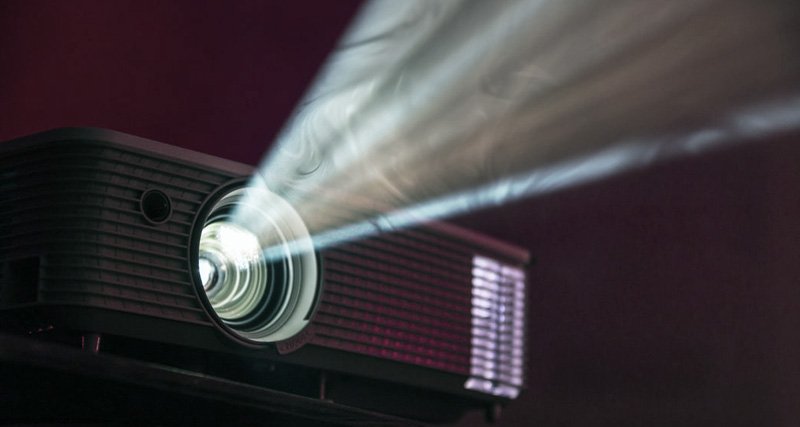
Do I Want a Digital Projector or An Opaque Projector?
Digital projectors are more modern and versatile. You can display digital images and connect a digital projector to your laptop or even for your phone.
As a result, they are speedy and easy to use. You can also play videos or films on a digital projector, making them multipurpose.
Another benefit is that you can adjust the image on the projector itself. For example, you can switch before color and black and white on many digital projectors.
However, digital projectors don’t tend to come cheap. That makes them less accessible for anyone on a budget, including students.
If you just need to transfer your designs onto a larger surface, an opaque projector may be all you need.
Opaque projects tend to be less expensive than digital models. But they’re not as convenient because you’ll need to print out the sketch to fit the projector opening.
Once you’ve done that, they’re pretty straightforward to use. For a cost-effective way to enlarge your designs, consider getting an opaque projector.
Opaque projectors are also simpler bits of kit, making them easy to repair or maintain. For example, you can swap out light bulbs yourself.
How to Choose the Best Art Projector
When you’re looking for the best art projector for tracing in instance, there are a few factors to consider.
You know all about the different types of projectors now, so you should know which type fits your needs.
But there are other things to think about to ensure you get the best tracing projector for you.
Portable or Overhead Projector?
First, you should decide whether you need a fixed or portable projector. A fixed or overhead projector can sometimes be more precise.
But you lose a lot of flexibility if you have a fixed projector. If you’re looking for the best projector for murals, portability is essential.
Unless you only ever work from one place, you should go for a compact, portable projector. That’s true even if you just want to switch up the direction or angle within your studio, too.
There are some excellent portable projectors on the market now. So, getting a smaller, compact projector doesn’t mean sacrificing quality.
Brightness
Some projectors will be brighter than others. The best digital art projectors tend to have LED lights rather than regular bulbs. LEDs are brighter, last longer, and don’t overheat.
The projector’s brightness shouldn’t be a significant problem if you’re working in the studio.
But if you need to work outside, then checking the brightness is critical. That’s especially true if you’re working on murals in bright daylight and full sun.
In that case, look for the brightest projector possible. The brightness is measured in lumens (sometimes referred to as lux).
Connectivity
You’ll want to check the connectivity of any model before you buy. The best digital projector will have WiFi connectivity so you can transfer images without cables.
But this feature isn’t available for all models. However, most projectors will have USB ports and memory card slots.
Size of Your Room
One last thing you shouldn’t overlook is to double-check the projector will work with your studio’s size.
You should look up the throw distance of the projector and see whether it matches your studio.
Projectors can fall under three different categories. These range from ultra-short throw to short throw and long throw.
You’ll need to buy the right type of projector for your room. So, make sure you measure up first!
Otherwise, you could find that the projector doesn’t fit your room’s dimensions. You don’t want to discover that after you’ve parted with your cash.
How Does an Art Projector Work?
Projectors used to work by shining light through a translucent film onto the wall. Nowadays, most digital projectors work in a similar but slightly different way.
You choose an image or video and open it on your projector. Then, it will appear on the display of the projector.
Next, a very bright light shines through the LCD. As a result, the pixels on the display are projected onto the surface in front of the projector.
Slide projectors will throw the image on the slide onto the wall. And overhead projectors enlarge whatever is on the transparency film in the same way.
Opaque projectors differ as they also use mirrors. They still work by beaming bright light onto the physical image (hand-drawn or printed).
But you’ll also find mirrors and a lens carefully positioned within an opaque projector. They reflect the image in larger proportions onto the wall.
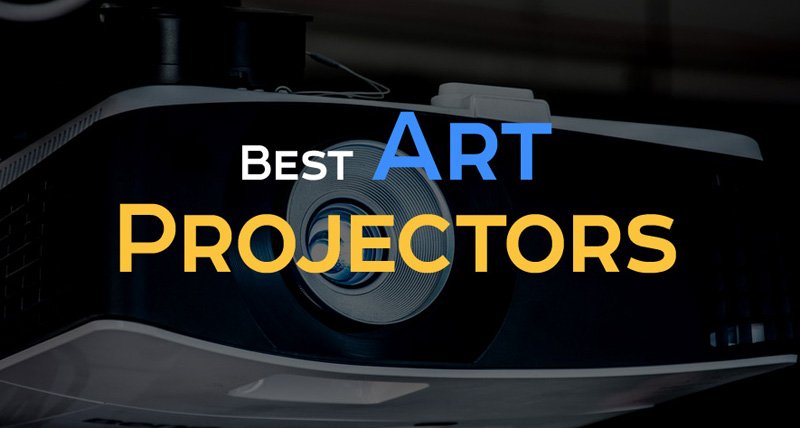
The Best Projectors for Artists
The Wrap Up
Buying the right art projector can seem like a daunting task at first. But once you narrow down the type of projector you want, you’re halfway there.
You need to compare the different factors laid out in our buying guide and consider your budget.
Keeping these things in mind, you’re sure to find the perfect projector for tracing and drawing.
If you’re not sure where to start, check out the recommended products above!
There’s something for everyone at every price point. But they’ve been carefully picked out as the best art projectors around right now!
Let me know which one you go for in the comments. And if you have any questions about the best projector for tracing images, ask away. I’ll get back to you as soon as possible. Happy tracing!
This post contains affiliate links. If you make a purchase, Proactive Creative may receive a small commission at no additional cost to you.

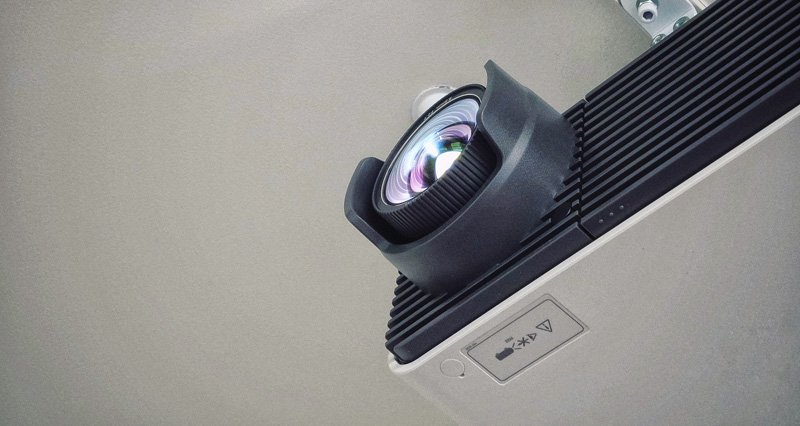
![[Netflix Officially & AI Auto Focus] VOPLLS 4K Projector with WiFi and Bluetooth, 3D Stereo Sound & Auto Keystone Smart Video Projector, 600 ANSI Outdoor Projector with Screen, MAX 300'' Display(Grey)](https://m.media-amazon.com/images/I/41ezTwF6VWL.jpg)




![[Auto Focus/4K Support] Projector with WiFi 6 and Bluetooth 5.2, 600ANSI Native 1080P Outdoor Movie Projector, WiMiUS P62 Auto 6D Keystone & 50% Zoom, Smart Home Projector for iOS/Android/TV Stick](https://m.media-amazon.com/images/I/51tFB5dw5RL.jpg)


![[Electric Focus] 4K Projector with 5G WiFi and Bluetooth, 17000L JOWLURK Mini Portable Projector, Outdoor Movie Projector, Home Theater Projector for iPhone/Android/TV Stick/HDMI/USB/Laptop/DVD/PS5](https://m.media-amazon.com/images/I/51f4ESeAI7L.jpg)


